Journal of Southern Medical University ›› 2024, Vol. 44 ›› Issue (10): 1887-1897.doi: 10.12122/j.issn.1673-4254.2024.10.07
Ziping SONG1,2( ), Lei HAN2, Zhuochao LIN2, Guangsen SHI1,2(
), Lei HAN2, Zhuochao LIN2, Guangsen SHI1,2( )
)
Received:2024-05-18
Online:2024-10-20
Published:2024-10-31
Contact:
Guangsen SHI
E-mail:2321976315@qq.com;shiguangsen@zidd.ac.cn
Supported by:Ziping SONG, Lei HAN, Zhuochao LIN, Guangsen SHI. Behavioral changes of transgenic mice carrying Adrb1-A187V mutation with short sleep duration under different dietary conditions[J]. Journal of Southern Medical University, 2024, 44(10): 1887-1897.
Add to citation manager EndNote|Ris|BibTeX
URL: https://www.j-smu.com/EN/10.12122/j.issn.1673-4254.2024.10.07
| Stage | Temperature (℃) | Time | Cycle |
|---|---|---|---|
| 1 | 95 | 3 min | 1× |
| 95 | 30 s | ||
| 2 | 60 | 30 s | 35× |
| 72 | 30 s | ||
| 3 | 72 | 5 min | 1× |
| 4 | 16 | ∞ | 1× |
Tab.1 PCR program setting
| Stage | Temperature (℃) | Time | Cycle |
|---|---|---|---|
| 1 | 95 | 3 min | 1× |
| 95 | 30 s | ||
| 2 | 60 | 30 s | 35× |
| 72 | 30 s | ||
| 3 | 72 | 5 min | 1× |
| 4 | 16 | ∞ | 1× |
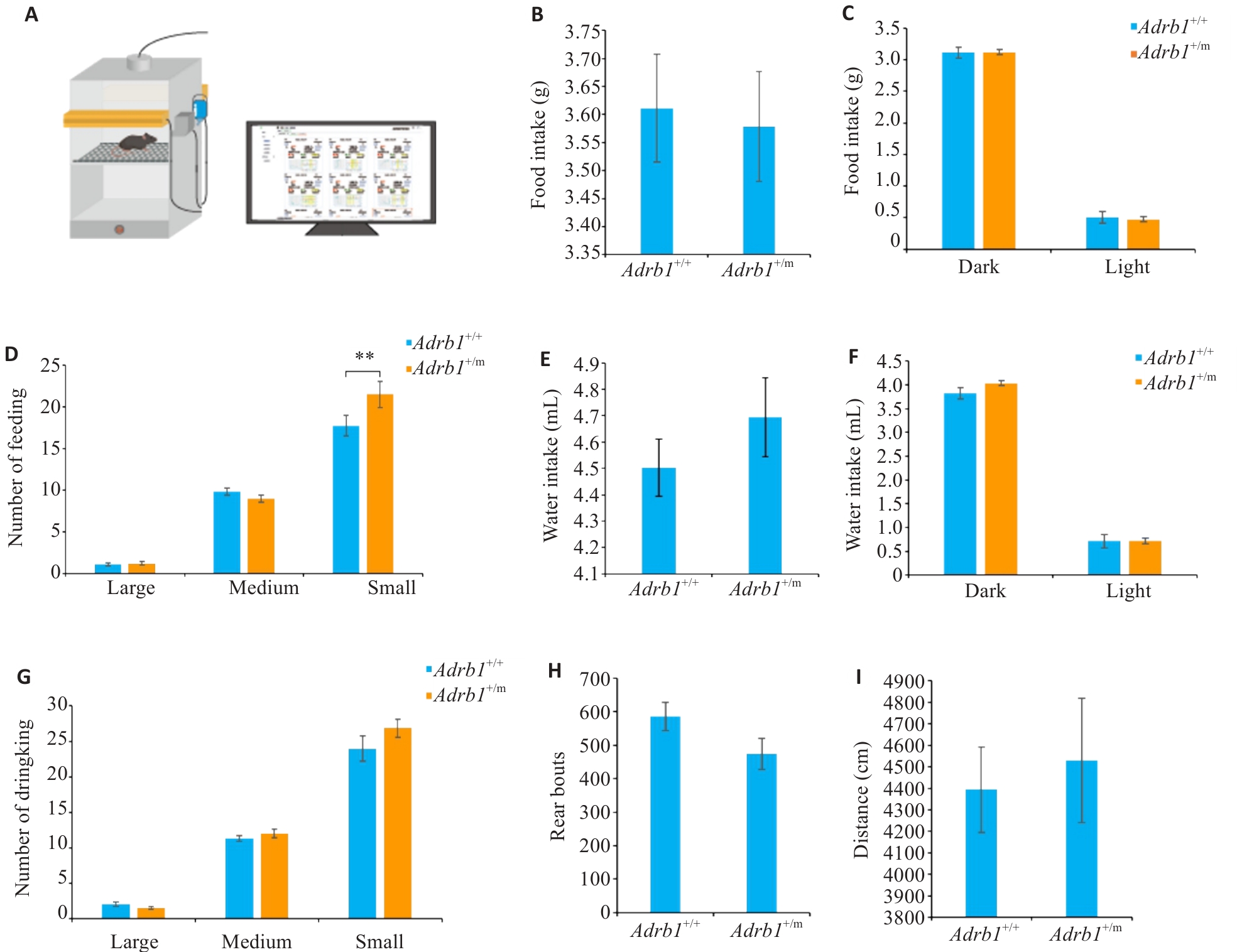
Fig.1 Activity and food/water intake of Adrb1+/+ and Adrb1+/m mice with free access to normal chow. A: Schematic of the mouse behavioral and feeding/drinking recording system. B: Total daily amount of food intake of Adrb1+/+ and Adrb1+/m mice. C: Total amount of food intake of Adrb1+/+ and Adrb1+/m mice in the dark and light phases. D: Daily number of "big meal", " medium meal" and "small meal" in Adrb1+/+ and Adrb1+/m mice. E: Total daily amount of water intake of Adrb1+/+ and Adrb1+/m mice. F: Total amount of wake intake of Adrb1+/+ and Adrb1+/m mice in dark and light phases. G: Daily numbers of "big water", " medium water " and "small water " in Adrb1+/+ and Adrb1+/m mice. H: Total daily numbers of rearing of Adrb1+/+ and Adrb1+/m mice. I: Total daily distance traveled by Adrb1+/+ and Adrb1+/m mice. Adrb1+/+ mice (n=25), Adrb1+/m mice (n=26), **P<0.01.
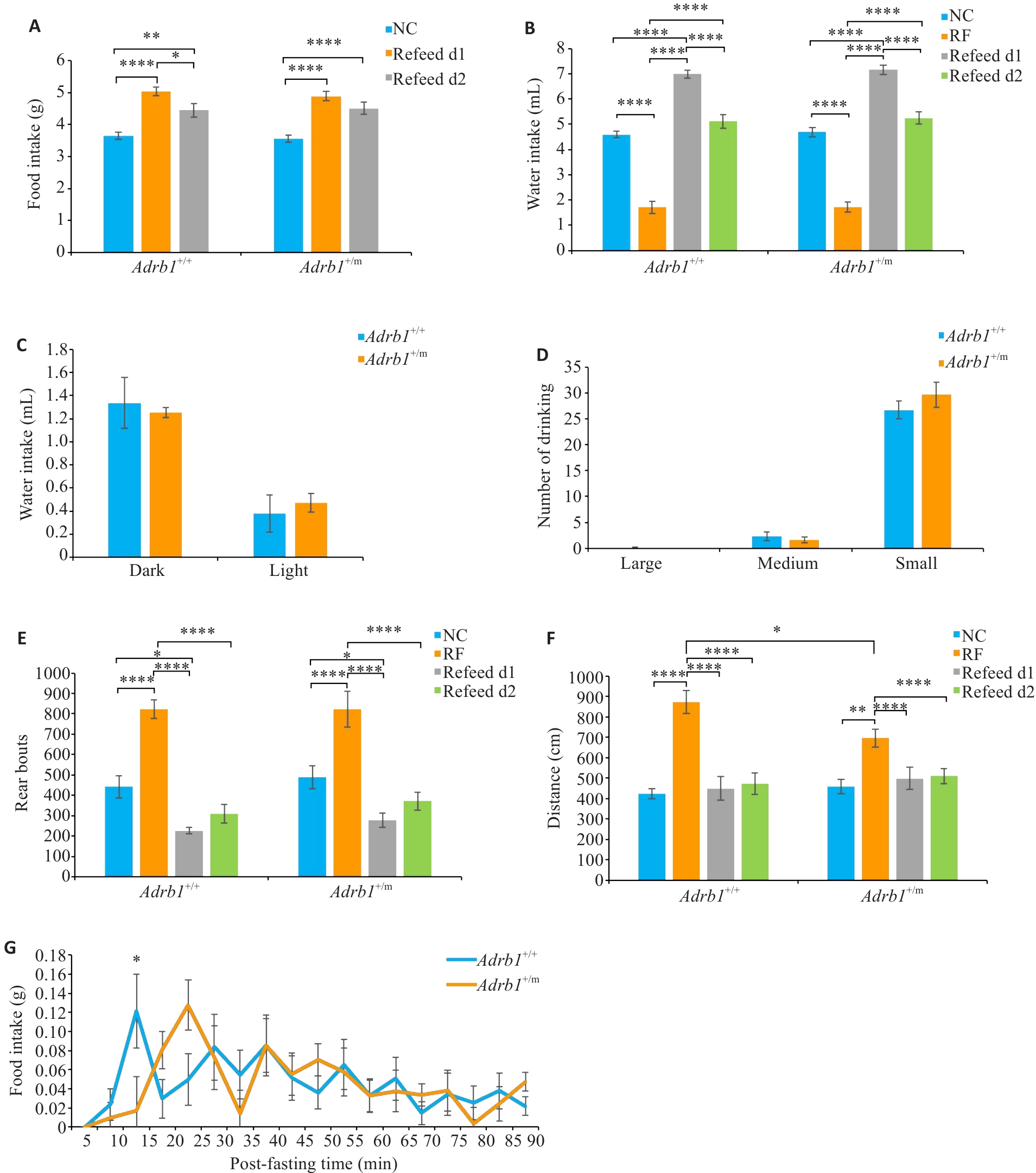
Fig.2 Changes in food intake and activity of Adrb1+/+ and Adrb1+/m mice during and after odor-retention fasting regime. A: Total daily food intake of Adrb1+/+ and Adrb1+/m mice during NC and Refeed. B: Total daily water intake of Adrb1+/+ and Adrb1+/m mice during NC, RF, and Refeed. C: Water intake of Adrb1+/+ and Adrb1+/m mice in the dark and light phase under RF conditions. D: Total daily number of "big water", "medium water " and "small water" of Adrb1+/+ and Adrb1+/m mice under RF conditions. E: Total daily number of rears of Adrb1+/+ and Adrb1+/m mice during NC, RF and Refeed. F: Total daily distance traveled by Adrb1+/+ and Adrb1+/m mice under NC, RF, and Refeed. G: Time course recording of food intake after odor retention fasting (RF) plotted every 5 min for 90 minu in Adrb1+/+ and Adrb1+/m mice. Adrb1+/+ mice (n=17), Adrb1+/m mice (n=19). NC: Normal condition; RF: Odor retetion fasting. *P<0.05, **P<0.01, ****P<0.0001.
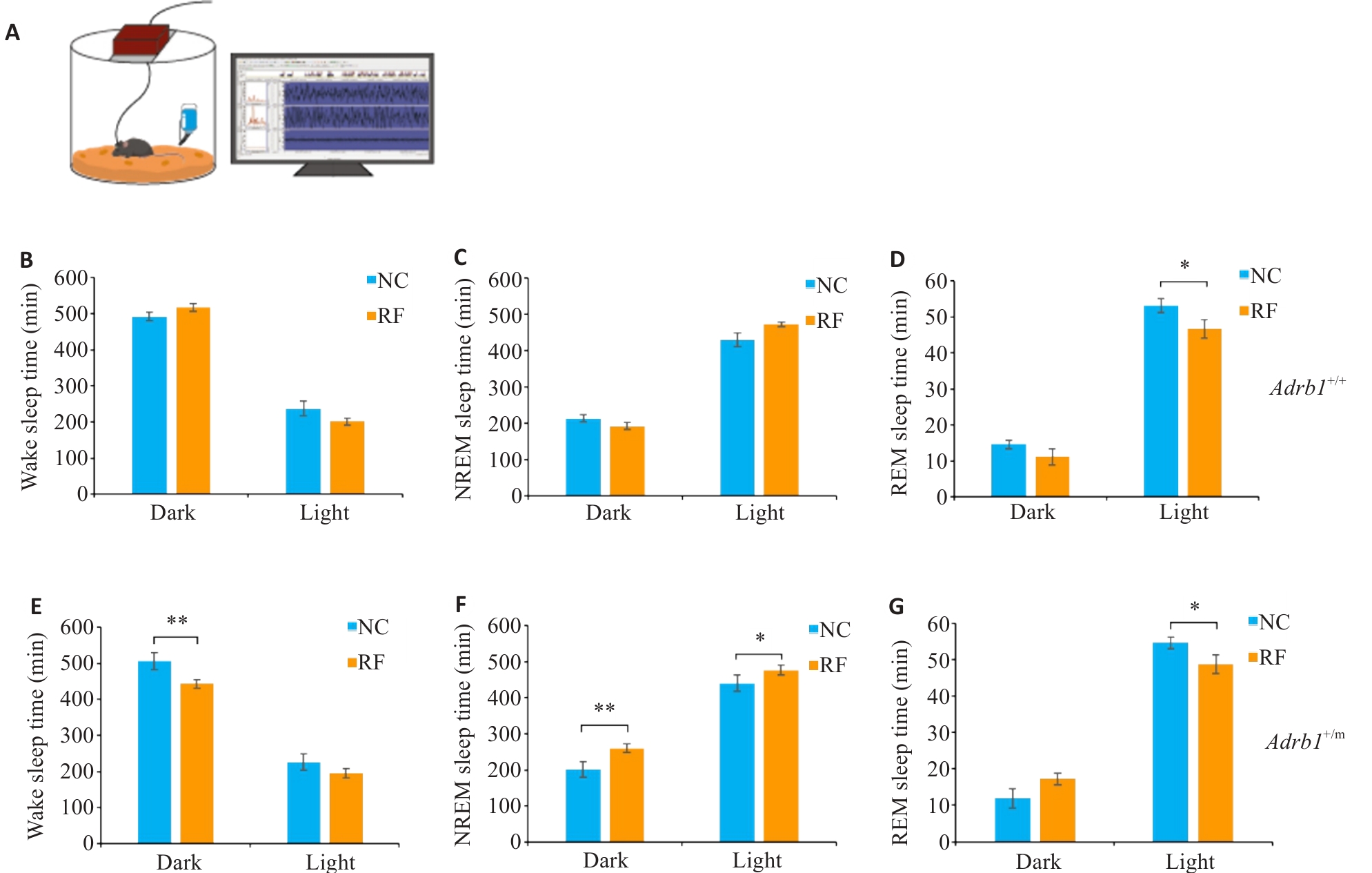
Fig.3 Sleep changes in Adrb1+/+ and Adrb1+/m mice under odor retention fasting condition. A: The multichannel EEG recording system. B-D: Total Wake (B), NREM (C), and REM (D) sleep time of Adrb1+/+ mice in the dark and light phase under NC and RF conditions. E-G: Total Wake (E), NREM (F), and REM (G) sleep time of Adrb1+/m mice in the dark and light phase under NC and RF conditions. Adrb1+/+ mice (n=6), Adrb1+/m mice (n=6), *P<0.05, **P<0.01.
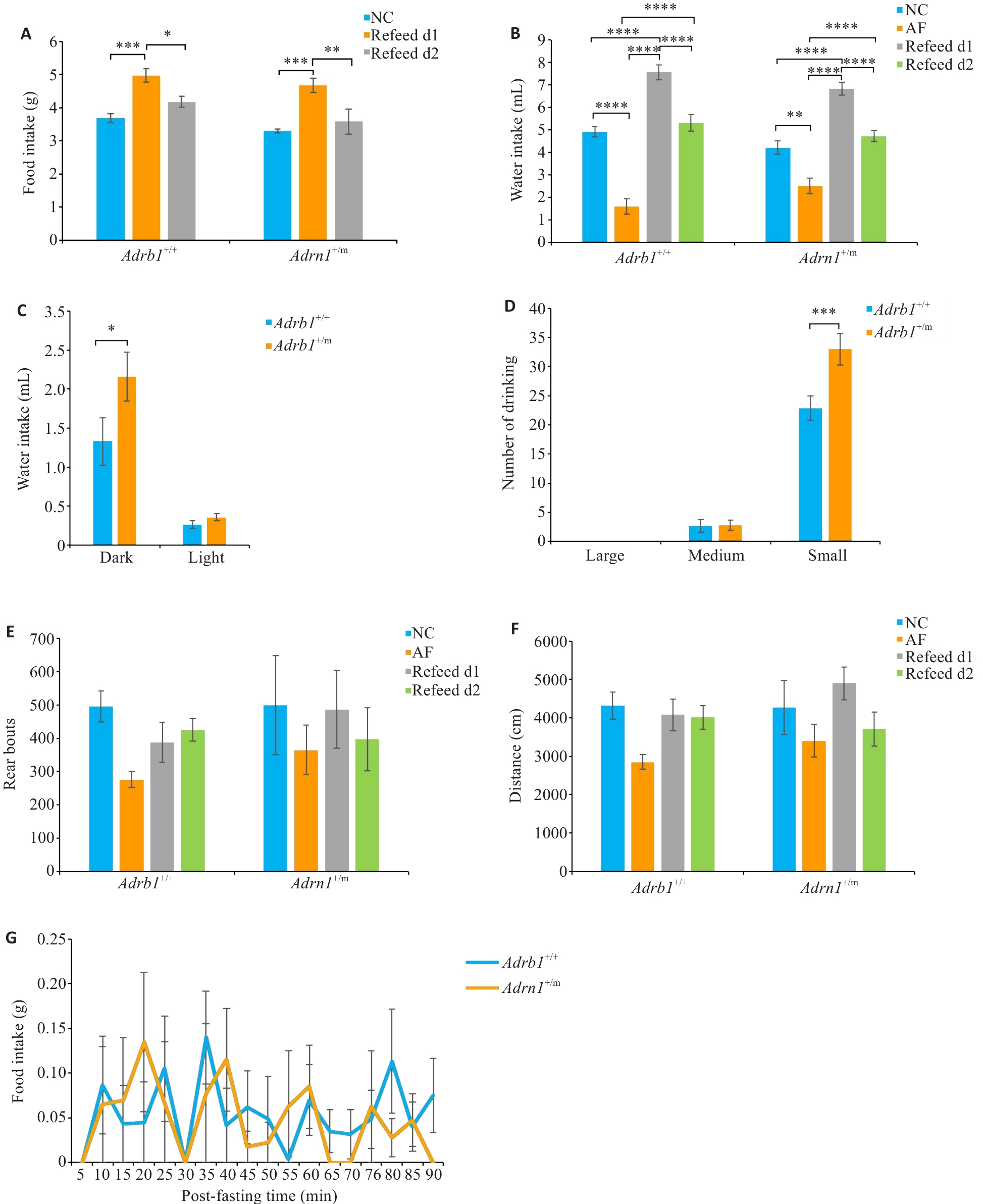
Fig.4 Changes in food intake and activity of Adrb1+/+ and Adrb1+/m mice during and after absolute fasting condition (AF). A: Total daily food intake of Adrb1+/+ and Adrb1+/m mice during NC and Refeed. B: Total daily water intake of Adrb1+/+ and Adrb1+/m mice during NC, AF, and Refeed. C: Water intake of Adrb1+/+ and Adrb1+/m mice in the dark and light phase under AF conditions. D: Total daily number of "big water", " medium water " and "small water " of Adrb1+/+ and Adrb1+/m mice under AF conditions. E: Total daily number of rears of Adrb1+/+ and Adrb1+/m mice during NC, AF and Refeed. F: Total daily distance traveled by Adrb1+/+ and Adrb1+/m mice under NC, AF, and Refeed. G: Time course recording of food intake after absolute fasting (AF) plotted every 5 min for 90 min in Adrb1+/+ and Adrb1+/m mice. Adrb1+/+ mice (n=6), Adrb1+/m mice (n=4-5), *P<0.05, **P<0.01, ***P<0.001, ****P<0.0001.
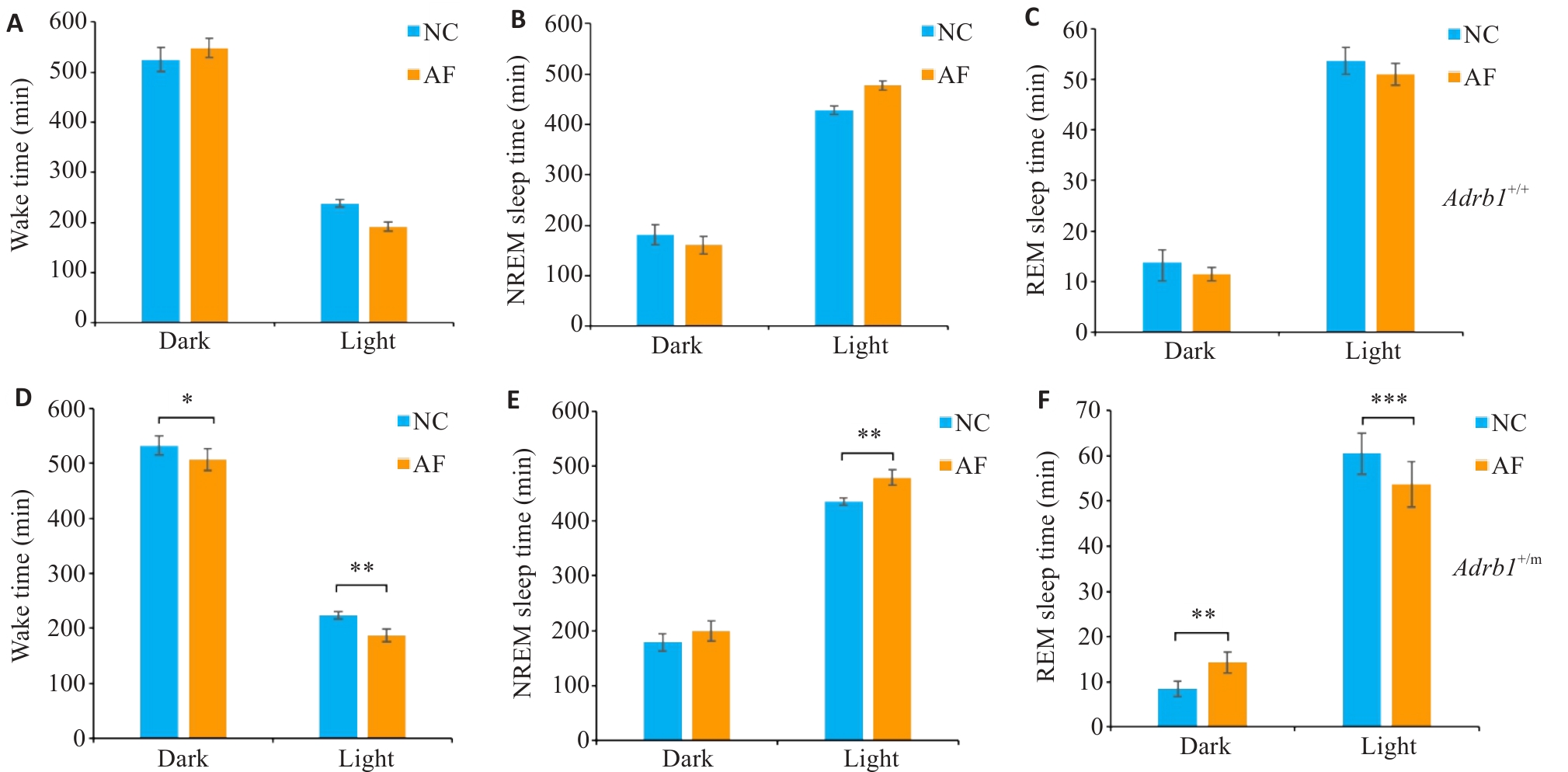
Fig.5 Sleep changes in Adrb1+/+ and Adrb1+/m mice under absolute fasting (AF) condition. A-C: Total Wake (A), NREM (B), and REM (C) sleep time of Adrb1+/+ mice in the dark and light phase under NC and AF conditions. D-F: Total Wake (D), NREM (E), and REM (F) sleep time of Adrb1+/m mice in the dark and light phase under NC and AF conditions. Adrb1+/+ mice (n=6), Adrb1+/m mice n=6), *P<0.05, **P<0.01, ***P<0.001.
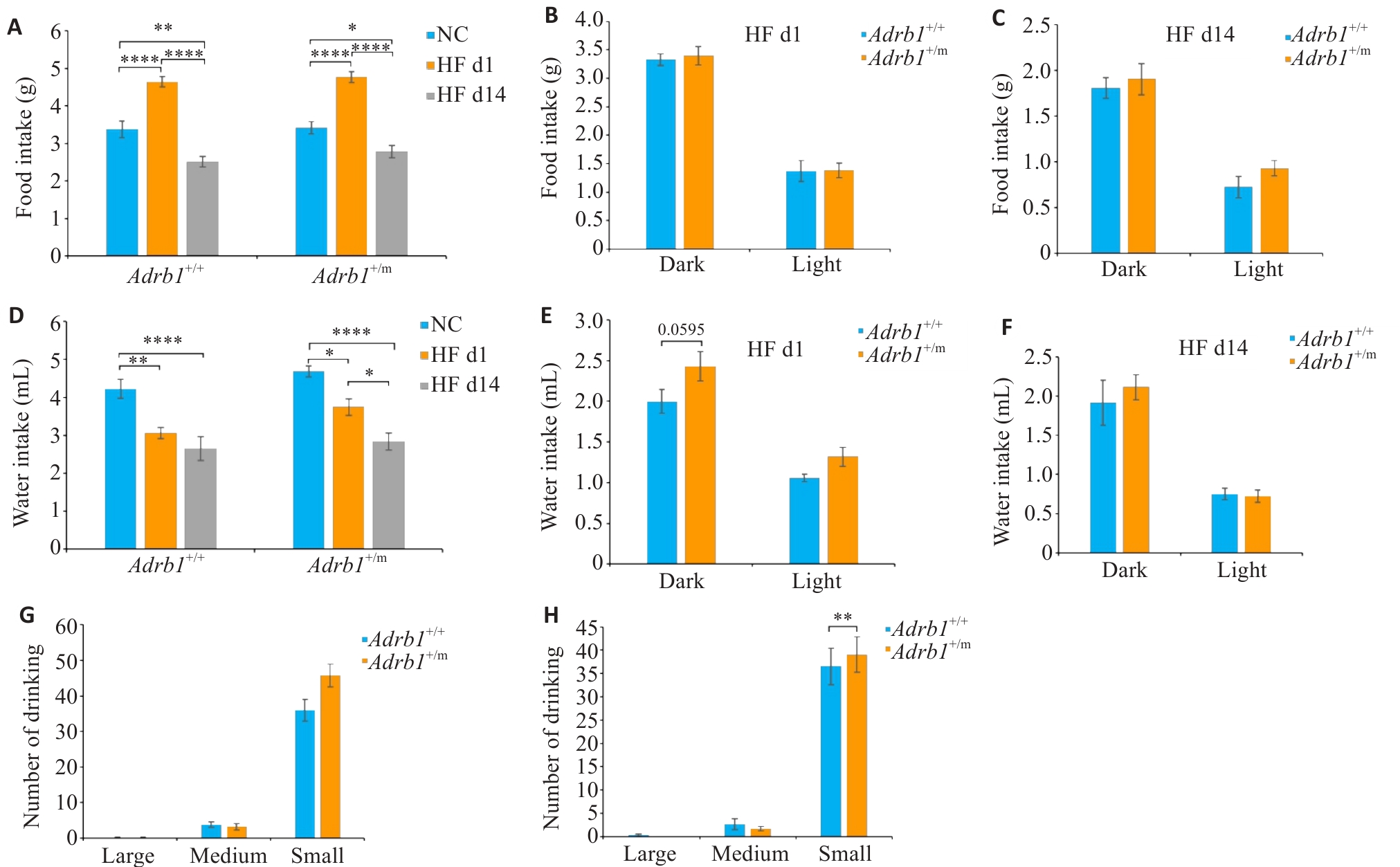
Fig.6 Effects of high-fat diet (HF) on feeding and drinking behaviors in Adrb1+/+ and Adrb1+/m mice. A: Total daily food intake of Adrb1+/+ and Adrb1+/m mice during NC, HF d1 and HF d14. B: Food intake of Adrb1+/+ and Adrb1+/m mice in the dark and light phase under HF d1. C: Total daily water intake of Adrb1+/+ and Adrb1+/m mice in the dark and light phase under HF d14. D: Total daily water intake of Adrb1+/+ and Adrb1+/m mice during NC、HF d1 and HF d14. E: Water intake of Adrb1+/+ and Adrb1+/m mice in the dark and light phase under HF d1. F: Water intake of Adrb1+/+ and Adrb1+/m mice in the dark and light phase under HF d14. G: Total daily number of "big water", "medium water " and "small water " of Adrb1+/+ and Adrb1+/m mice under HF d1 conditions. H: Total daily number of "big water", " medium water " and "small water " in Adrb1+/+ and Adrb1+/m mice under HF d14 conditions. Adrb1+/+ mice (n=6), Adrb1+/m mice (n=7, except n=4 for drinking at HF d14, E G I), *P<0.05, **P<0.01, ***P<0.001, ****P<0.0001.
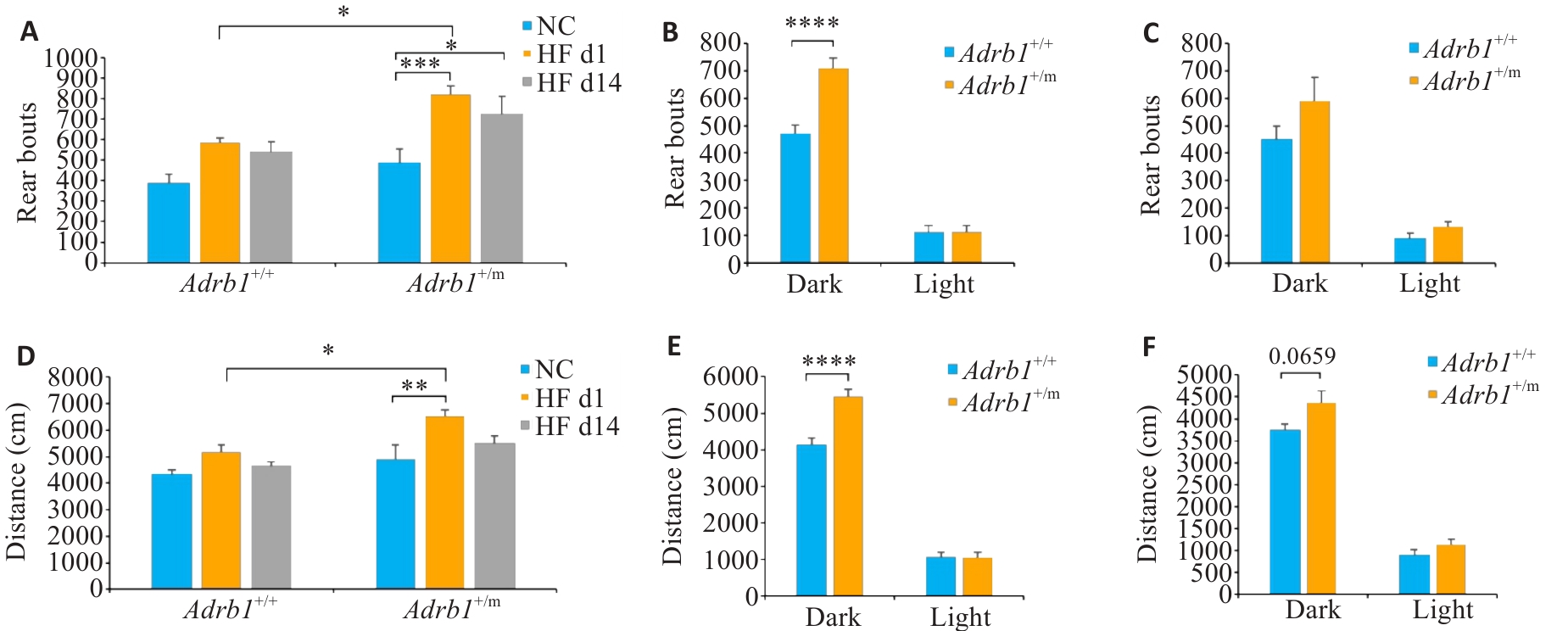
Fig.7 Effects of high-fat diet (HF) on locomotor activity of Adrb1+/+ and Adrb1+/m mice. A: Total daily number of rears of Adrb1+/+ and Adrb1+/m mice during NC, HF d1 and HF d14. B: Rear bouts of Adrb1+/+ and Adrb1+/m mice in the dark and light phase under HF d1. C: Rear bouts of Adrb1+/+ and Adrb1+/m mice in the dark and light phase under HF d14. D: Total daily distance traveled by Adrb1+/+ and Adrb1+/m mice under NC, HF D1 and HF d14. E: Distance traveled by Adrb1+/+ and Adrb1+/m mice in the dark and light phase under HF d1. F: Distance traveled by Adrb1+/+ and Adrb1+/m mice in the dark and light phase under HF d14. Adrb1+/+ mice (n=6), Adrb1+/m mice (n=7), *P<0.05, **P<0.01, ***P<0.001, ****P<0.0001.
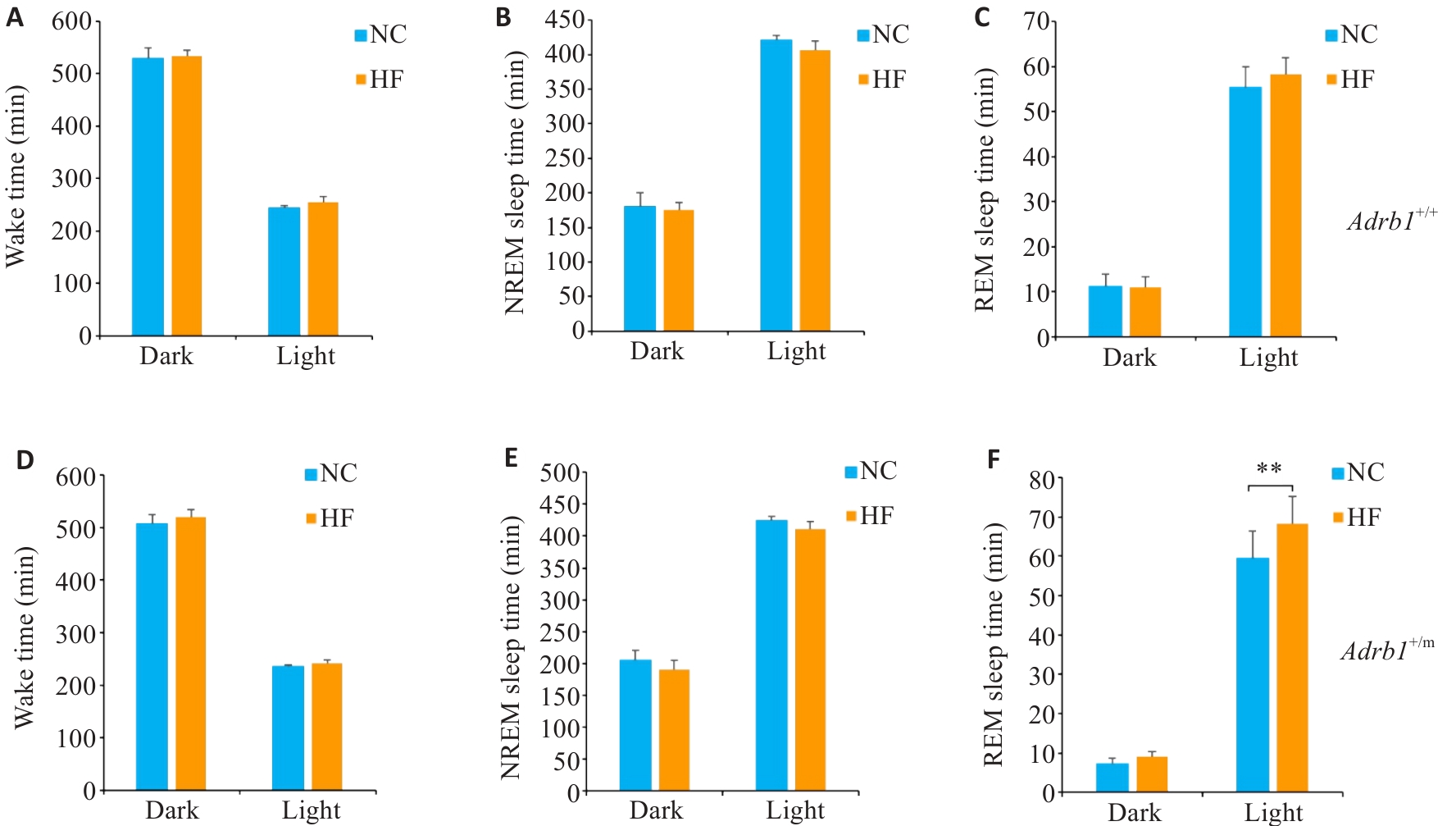
Fig.8 Sleep changes in Adrb1+/+ and Adrb1+/m mice under high-fat diet (HF) condition. A-C: Total Wake (A), NREM (B), and REM (C) sleep time in Adrb1+/+ mice in the dark and light phase under NC and HF conditions. D-F: Total Wake (D), NREM (E), and REM (F) sleep time in Adrb1+/m mice in the dark and light phase under NC and HF conditions. Data are presented as Mean±SE (n=6). **P<0.01.
| 1 | Zuraikat FM, Wood RA, Barragán R, et al. Sleep and diet: mounting evidence of a cyclical relationship[J]. Annu Rev Nutr, 2021, 41: 309-32. |
| 2 | Shukla C, Basheer R. Metabolic signals in sleep regulation: recent insights[J]. Nat Sci Sleep, 2016, 8: 9-20. |
| 3 | Panagiotou M, Meijer JH, Deboer T. Chronic high-caloric diet modifies sleep homeostasis in mice[J]. Eur J Neurosci, 2018, 47(11): 1339-52. |
| 4 | Luppi M, Al-Jahmany AA, del Vecchio F, et al. Wake-sleep and cardiovascular regulatory changes in rats made obese by a high-fat diet[J]. Behav Brain Res, 2017, 320: 347-55. |
| 5 | Kang J, Park M, Oh CM, et al. High-fat diet-induced dopaminergic dysregulation induces REM sleep fragmentation and ADHD-like behaviors[J]. Psychiatry Res, 2023, 327: 115412. |
| 6 | dos Santos SO, Arias J, Ribeiro AA, et al. Incrimination of Lutzomyia cruzi as a vector of American visceral leishmaniasis[J]. Med Vet Entomol, 1998, 12(3): 315-7. |
| 7 | Theorell-Haglöw J, Lemming EW, Michaëlsson K, et al. Sleep duration is associated with healthy diet scores and meal patterns: results from the population-based EpiHealth study[J]. J Clin Sleep Med, 2020, 16(1): 9-18. |
| 8 | Chaput JP, McHill AW, Cox RC, et al. The role of insufficient sleep and circadian misalignment in obesity[J]. Nat Rev Endocrinol, 2023, 19(2): 82-97. |
| 9 | Cheng FW, Li YP, Winkelman JW, et al. Probable insomnia is associated with future total energy intake and diet quality in men[J]. Am J Clin Nutr, 2016, 104(2): 462-9. |
| 10 | Mossavar-Rahmani Y, Weng J, Wang R, et al. Actigraphic sleep measures and diet quality in the Hispanic Community Health Study/Study of Latinos Sueño ancillary study[J]. J Sleep Res, 2017, 26(6): 739-46. |
| 11 | Fenton S, Burrows TL, Skinner JA, et al. The influence of sleep health on dietary intake: a systematic review and meta-analysis of intervention studies[J]. J Hum Nutr Diet, 2021, 34(2): 273-85. |
| 12 | Markwald RR, Melanson EL, Smith MR, et al. Impact of insufficient sleep on total daily energy expenditure, food intake, and weight gain[J]. Proc Natl Acad Sci U S A, 2013, 110(14): 5695-700. |
| 13 | Morselli L, Leproult R, Balbo M, et al. Role of sleep duration in the regulation of glucose metabolism and appetite[J]. Best Pract Res Clin Endocrinol Metab, 2010, 24(5): 687-702. |
| 14 | Penev PD. Sleep deprivation and energy metabolism: to sleep, perchance to eat[J]? Curr Opin Endocrinol Diabetes Obes, 2007, 14(5): 374-81. |
| 15 | Watson NF, Badr MS, Belenky G, et al. Recommended amount of sleep for a healthy adult: a joint consensus statement of the American academy of sleep medicine and sleep research society[J]. Sleep, 2015, 38(6): 843-4. |
| 16 | Hirshkowitz M, Whiton K, Albert SM, et al. National Sleep Foundation's sleep time duration recommendations: methodology and results summary[J]. Sleep Health, 2015, 1(1): 40-3. |
| 17 | Shi GS, Xing LJ, Wu D, et al. A rare mutation of β1-adrenergic receptor affects sleep/wake behaviors[J]. Neuron, 2019, 103(6): 1044-55. e7. |
| 18 | Kjaerby C, Andersen M, Hauglund N, et al. Memory-enhancing properties of sleep depend on the oscillatory amplitude of norepinephrine[J]. Nat Neurosci, 2022, 25(8): 1059-70. |
| 19 | Poe GR, Foote S, Eschenko O, et al. Locus coeruleus: a new look at the blue spot[J]. Nat Rev Neurosci, 2020, 21(11): 644-59. |
| 20 | Berridge CW, Schmeichel BE, España RA. Noradrenergic modulation of wakefulness/arousal[J]. Sleep Med Rev, 2012, 16(2): 187-97. |
| 21 | Szabadi E. Functional neuroanatomy of the central noradrenergic system[J]. J Psychopharmacol, 2013, 27(8): 659-93. |
| 22 | Abell TL, Bernstein RK, Cutts T, et al. Treatment of gastroparesis: a multidisciplinary clinical review[J]. Neurogastroenterol Motil, 2006, 18(4): 263-83. |
| 23 | Parkman HP, Yates KP, Hasler WL, et al. Dietary intake and nutritional deficiencies in patients with diabetic or idiopathic gastroparesis[J]. Gastroenterology, 2011, 141(2): 486-98, 498. e1-7. |
| 24 | Hassanzadeh S, Saneei P, Keshteli AH, et al. Meal frequency in relation to prevalence of functional dyspepsia among Iranian adults[J]. Nutrition, 2016, 32(2): 242-8. |
| 25 | Holmbäck I, Ericson U, Gullberg B, et al. A high eating frequency is associated with an overall healthy lifestyle in middle-aged men and women and reduced likelihood of general and central obesity in men[J]. Br J Nutr, 2010, 104(7): 1065-73. |
| 26 | Titan SM, Bingham S, Welch A, et al. Frequency of eating and concentrations of serum cholesterol in the Norfolk population of the European prospective investigation into cancer (EPIC-Norfolk): cross sectional study[J]. BMJ, 2001, 323(7324): 1286-8. |
| 27 | Ma YS, Bertone ER, Stanek EJ 3rd, et al. Association between eating patterns and obesity in a free-living US adult population[J]. Am J Epidemiol, 2003, 158(1): 85-92. |
| 28 | Ruidavets JB, Bongard V, Bataille V, et al. Eating frequency and body fatness in middle-aged men[J]. Int J Obes Relat Metab Disord, 2002, 26(11): 1476-83. |
| 29 | Carlson O, Martin B, Stote KS, et al. Impact of reduced meal frequency without caloric restriction on glucose regulation in healthy, normal-weight middle-aged men and women[J]. Metabolism, 2007, 56(12): 1729-34. |
| 30 | Ngo FY, Li HH, Zhang HQ, et al. Acute fasting modulates food-seeking behavior and neural signaling in the piriform cortex[J]. Nutrients, 2022, 14(19): 4156. |
| 31 | Siegel JM. Sleep function: an evolutionary perspective[J]. Lancet Neurol, 2022, 21(10): 937-46. |
| Viewed | ||||||
|
Full text |
|
|||||
|
Abstract |
|
|||||